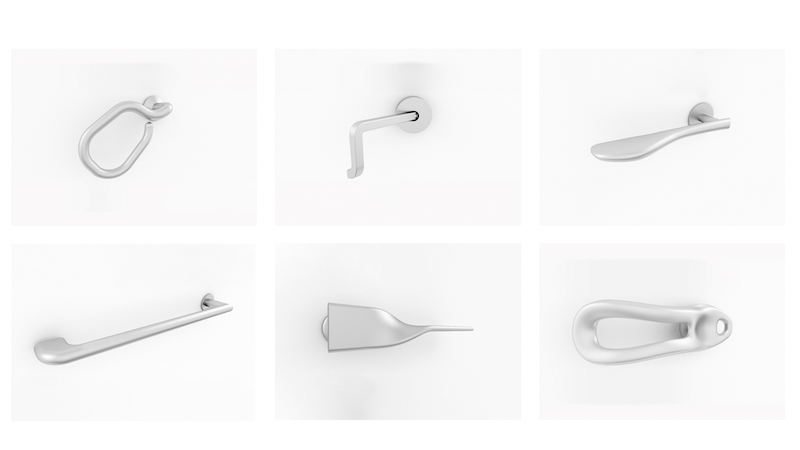Top international design and architecture firm Perkins Eastman recently released its newest white paper, “A Handle on Accessibility: Designing for a Future of Limited Mobility,” co-authored by Associate Michael Schur AIA, LEED AP, and Joshua Bergman, both based in the firm’s Chicago office. The paper marks the culmination of a six-month-long, in-house exercise in which Perkins Eastman’s Chicago staff engaged in various “empathy experiments”—e.g. simulating the tactile and sensory challenges encountered daily by seniors—and then broke off into smaller teams to design and fabricate a diverse array of door handles using 3-D printing technology. By applying a user-centered approach to design, integrating user analysis, and studying the physical constraints associated with aging, “A Handle on Accessibility” from start to finish set out to create a more accessible door handle and develop a clear understanding of the empathetic design process.
There is an accessibility challenge facing the U.S. According to the most recent census data and studies conducted by the U.S. Department of Health and Human Services, an estimated 1 in 5 people will be aged 65 or older by 2040. “These statistics,” say the authors, “suggest that in less than 25 years, nearly a quarter of the U.S. population will be faced with the physical limitations that come with aging: reduction of mobility and dexterity, visual and hearing impairment, bone and muscle weakness, and immune and memory deterioration.” On the front lines of this challenge is the door handle, a ubiquitous product that often gets overlooked, or otherwise tends to be designed with a form-before-function approach.
Following the teams’ empathy experiments, in which participating design and thought leaders formed evaluations based on first-hand limited-mobility and sensory deprivation exercises, solutions for new types of door handles began to materialize. The resulting six prototypes fall into three categories: 1) handles that adapted/evolved traditional handle forms (the “Seed” and “Twist” handles), 2) handles that rethought the handle form (the “Hand Hold” and “Loop” handles), and 3) handles that rethought how doors can be operated (the “Long” and “Crank” handles).
“As the U.S. population continues to age,” write Schur and Bergman, “[we as designers] have the opportunity to advance design through the re-working of overlooked elements of everyday life … The range and variety of the final designs emphasize the power of recognizing others’ needs…these explorations illustrate that the value of what we design ultimately lies in how well we understand the end-user and how well we are able to design for them.”
“A Handle on Accessibility” is available for free download here.
Related Stories
| Jan 28, 2014
16 awe-inspiring interior designs from around the world [slideshow]
The International Interior Design Association released the winners of its 4th Annual Global Excellence Awards. Here's a recap of the winning projects.
| Jan 13, 2014
Custom exterior fabricator A. Zahner unveils free façade design software for architects
The web-based tool uses the company's factory floor like "a massive rapid prototype machine,” allowing designers to manipulate designs on the fly based on cost and other factors, according to CEO/President Bill Zahner.
| Jan 11, 2014
Getting to net-zero energy with brick masonry construction [AIA course]
When targeting net-zero energy performance, AEC professionals are advised to tackle energy demand first. This AIA course covers brick masonry's role in reducing energy consumption in buildings.
Smart Buildings | Jan 7, 2014
9 mega redevelopments poised to transform the urban landscape
Slowed by the recession—and often by protracted negotiations—some big redevelopment plans are now moving ahead. Here’s a sampling of nine major mixed-use projects throughout the country.
| Dec 13, 2013
Safe and sound: 10 solutions for fire and life safety
From a dual fire-CO detector to an aspiration-sensing fire alarm, BD+C editors present a roundup of new fire and life safety products and technologies.
| Dec 10, 2013
16 great solutions for architects, engineers, and contractors
From a crowd-funded smart shovel to a why-didn’t-someone-do-this-sooner scheme for managing traffic in public restrooms, these ideas are noteworthy for creative problem-solving. Here are some of the most intriguing innovations the BD+C community has brought to our attention this year.
| Nov 27, 2013
Wonder walls: 13 choices for the building envelope
BD+C editors present a roundup of the latest technologies and applications in exterior wall systems, from a tapered metal wall installation in Oklahoma to a textured precast concrete solution in North Carolina.
| Nov 26, 2013
Construction costs rise for 22nd straight month in November
Construction costs in North America rose for the 22nd consecutive month in November as labor costs continued to increase, amid growing industry concern over the tight availability of skilled workers.
| Nov 25, 2013
Building Teams need to help owners avoid 'operational stray'
"Operational stray" occurs when a building’s MEP systems don’t work the way they should. Even the most well-designed and constructed building can stray from perfection—and that can cost the owner a ton in unnecessary utility costs. But help is on the way.
| Nov 19, 2013
Top 10 green building products for 2014
Assa Abloy's power-over-ethernet access-control locks and Schüco's retrofit façade system are among the products to make BuildingGreen Inc.'s annual Top-10 Green Building Products list.

















